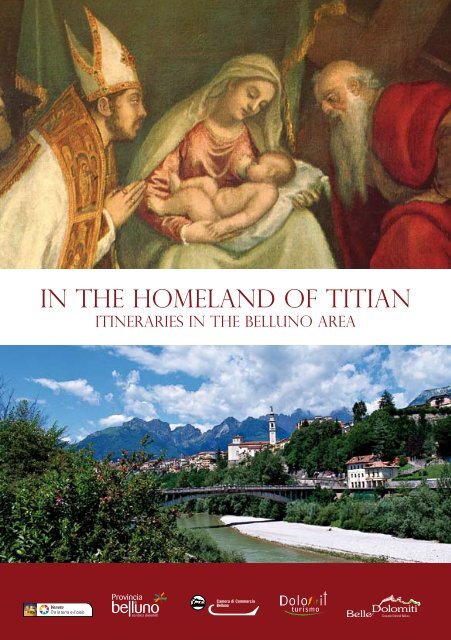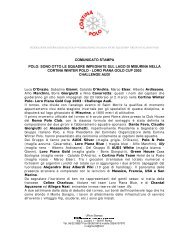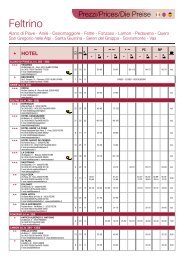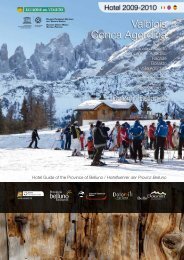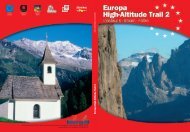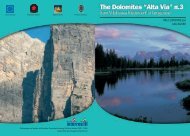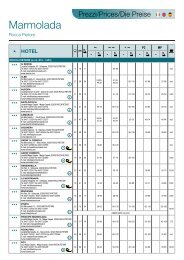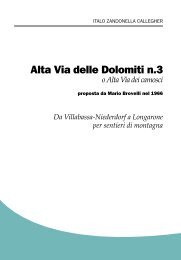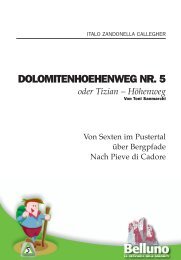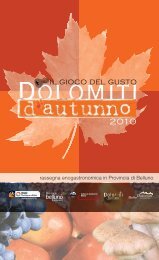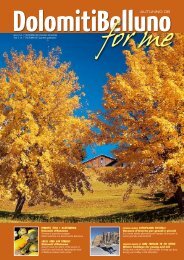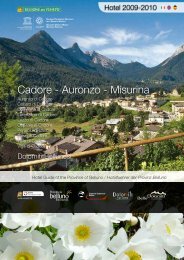IN THE HOMELAND OF TITIAN - Dolomiti
IN THE HOMELAND OF TITIAN - Dolomiti
IN THE HOMELAND OF TITIAN - Dolomiti
You also want an ePaper? Increase the reach of your titles
YUMPU automatically turns print PDFs into web optimized ePapers that Google loves.
In the homeland of tItIan<br />
ItInerarIes In the Belluno area<br />
Itinerario “Da Belluno a Feltre, seguendo il fiume Piave„
Titian was born in Pieve di Cadore somewhere between 1488 and 1490,<br />
and was the second child of Gregorio Vecellio, who descended from an<br />
important, wealthy family of notaries, lawyers and administrators. He<br />
was brought up to be a shrewd manager of money and to tend towards a<br />
secluded lifestyle, which he maintained even after becoming an artist of<br />
international renown.<br />
At a very young age he moved to Venice, where he became an apprentice<br />
of Gentile and Giovanni Bellini. Before turning twenty he was already<br />
working together with Giorgione on the frescoes of the Fondaco dei Tedeschi (the German<br />
Exchange), and this was but the beginning of a brilliant career which would was to render<br />
Titian one of the most famous artists of his time; his services were contended by the noble<br />
families of Italy, and he worked for both the Gonzaga family of Mantova and the Dukes of<br />
Urbino. In 1542 he began working for Pope Paul III and his family; during this period his fame as<br />
a portrait artist continued to grow, and he was given the opportunity to paint the Emperor<br />
Charles V on the occasion of his coronation in 1530, becoming the favourite artist of both<br />
Charles and his son, the future King Philip II of Spain.<br />
Titian died on the 27th of August 1576, at the height of the plague outbreak, leaving unfinished<br />
the work he would have liked to have been placed on his tombstone: the “Pietà”.<br />
In spite of his worldwide fame as an artist, throughout his life Titian maintained close links<br />
with the land of his birth. These links can be observed in many of his works, with the Belluno<br />
Dolomites serving as a splendid background for a number of famous portraits.<br />
the provInce of Belluno,<br />
steeped In art and hIstory.<br />
The exhibition “Titian. The Final Act” (Belluno, Palazzo Crepadona,<br />
and Pieve di Cadore, Palazzo della Magnifica Comunità di<br />
Cadore: September 2007 –January 2008) has re-awakened the<br />
interest of visitors in the art and in the history of the province<br />
of Belluno.<br />
As well as works by the great Renaissance artist from the Cadore<br />
himself, in the ancient buildings and churches of Titian’s<br />
homeland art lovers and history enthusiasts will find a great<br />
deal of interest to visit and landscapes to admire.<br />
The aim of this booklet is to suggest a few itineraries in the<br />
area which offer the opportunity to learn more not only<br />
about the work of Titian and his apprentices, but also about<br />
the splendid landscape and historical buildings of the province<br />
of Belluno. Along these four routes, you can admire<br />
paintings, frescoes and sculptures; but above all, you will<br />
have the opportunity to truly understand and appreciate<br />
the bond that exists between artworks and the environmental<br />
and cultural context within which they are created.<br />
Often these routes will take you off the beaten track<br />
and into the outskirts of towns and villages, through tiny hamlets<br />
with their little-known churches, villas and mansion houses, in an area which stretches<br />
from the Piave valley to the most famous peaks in the Dolomites.<br />
Pieve di Cadore, bronze statue of Titian<br />
placed in the centre of Piazza Tiziano (Antonio Dal Zotto, 1800)
In the homeland of tItIan<br />
ItInerarIes In the Belluno area<br />
1 Itinerary “From Belluno to Feltre,<br />
along the flow of the River Piave„<br />
2 Itinerary “Home to Titian: the Cadore„<br />
Itinerary “Around the Pelmo„<br />
4 Itinerary “The green countryside of Comelico„<br />
Tourist Information Offices
1<br />
Itinerary “From Belluno to Feltre, along the flow of the River Piave„<br />
Belluno: historic centre and exhibition; Sedico: Church of S. Maria Annunziata and Oratory<br />
of S. Nicolò; San Gregorio nelle Alpi: Church of San Gregorio Papa; Cesiomaggiore: Ethnographical<br />
Museum of the Province of Belluno and the <strong>Dolomiti</strong> Bellunesi National Park; Feltre:<br />
historical centre, civic museums and Sanctuary of San Vittore and Santa Corona; Lentiai:<br />
Church of Santa Maria Assunta; Mel: historic centre, Zumelle Castle; Trichiana: church of<br />
Pialdier; Limana; Belluno. Length: approx. 74 km<br />
The itinerary starts out from the provincial<br />
capital Belluno, which sits on a rise at the<br />
confluence of the Piave River and the Ardo Torrent,<br />
in a still-unspoilt valley surrounded by the<br />
splendid Dolomites to the north and the Veneto<br />
Pre-Alps to the south. The lovely little historic<br />
centre, throughout most of which traffic restrictions<br />
are in operation, is extremely touristfriendly<br />
and all the most interesting monuments<br />
can easily and conveniently be reached on foot:<br />
Piazza S.Stefano (•1) with the church of the<br />
same name (15th century); Porta Dojona,<br />
the main gateway to the Renaissance Old Town;<br />
Piazza del Mercato (also known as Piazza<br />
delle Erbe) with the Monte di Pietà (Pawnbroker’s)<br />
building; 16th century townhouses and<br />
numerous porti- •1<br />
coes; Via S.Pietro<br />
with the Church of<br />
San Pietro; Piazza<br />
Duomo,which<br />
has been described<br />
as one of the most<br />
beautiful squares in<br />
the country, with the<br />
Cathedral of S. Martino,<br />
the magnificent<br />
bell tower designed<br />
by Filippo Juvarra<br />
(one of the finest Baroque<br />
bell towers in Italy); Palazzo Piloni with<br />
its frescoed reception hall; Palazzo dei Rettori;<br />
Porta Rugo, the southern gateway to the city,<br />
used by those arriving from the river port of<br />
Borgo Piave below.<br />
As you go along the SS50 trunk road towards<br />
VillA PAgAni-gAggiA PARk<br />
At Socchieva di San Fermo, just km from the trunk<br />
road to Feltre, hidden away among the greenery<br />
lies Villa Gaggia (• ), surrounded by a superb park<br />
designed by the landscape gardener Alexander<br />
Poiteau Le Terrier. The villa hosted the last meeting<br />
between Hitler and Mussolini.<br />
Civic Museum of Belluno - Piazza Duomo 6 - tel. fax 04 7 9448 6 - www.comune.belluno.it<br />
4 Itinerary “From Belluno to Feltre, along the flow of the River Piave„<br />
•2
Feltre, the first<br />
stop on the route<br />
is Sedico, where<br />
you can admire the<br />
Madonna col Bambino<br />
by Titian and his<br />
brother Francesco<br />
Vecellio(•3) in the<br />
church of Santa<br />
Maria Annunziata.<br />
The village of Sedico<br />
lies at the<br />
confluence of the<br />
Cordevole Torrent<br />
and the Piave River, and for centuries it was an<br />
important point on the river route along which<br />
timber and copper were transported on rafts<br />
from the Agordino area to the Cadore; a thriving<br />
trade developed in the area, evidence of<br />
which can be seen in the historic noble family<br />
villas (Villa Zuppani in Pasa, Villa De’ Manzoni<br />
in Patt and Villa Rudio in Landris).<br />
Return onto the trunk road for Feltre, and after<br />
just a few minutes<br />
it is time to<br />
stop off again at<br />
the small village<br />
of Bribano,<br />
where, in the<br />
ancient Oratory<br />
of S. Nicolò<br />
(16th century),<br />
•3<br />
you can admire a triptych by Agostino da Lodi.<br />
From here the route continues to Santa Giustina<br />
and turns right towards Cesiomaggiore.<br />
Here it is worth taking a brief detour to San<br />
Gregorio nelle Alpi (the highest municipality<br />
in the whole valley), where, as well as a splendid<br />
view out over the whole area, you can admire<br />
an altarpiece, Madonna col Bambino, by Moretto<br />
da Brescia (•4). From here the route goes<br />
back onto the piedmont road and continues on<br />
towards Cesiomaggiore, where the Ethnographical<br />
Museum of the Province of Belluno<br />
and of the <strong>Dolomiti</strong> Bellunesi National Park is<br />
housed inside Villa Avogardo in the Seravella<br />
TowARDs THe AgoRDino AReA<br />
Just under 0 km from Belluno, in a peaceful, quiet<br />
area of the <strong>Dolomiti</strong> Bellunesi National Park, lies the<br />
Charterhouse of Vedana (•5). The building can be<br />
admired from the outside only, because it is home to<br />
an order of enclosed nuns, but it is certainly worth<br />
making a detour to visit, on account of both its fine<br />
architecture and the lake below, of glacial origin.<br />
To reach the Charterhouse, follow the trunk road for<br />
Agordo, cross the river at PonteMas and turn right<br />
towards S. Gottardo.<br />
Also on the road for Agordo, along the banks of the<br />
Cordevole Torrent, after about 0 kilometres, you<br />
can see a recently-restored mining complex, the Val<br />
Imperina, inside which there is a visitor centre.<br />
The main square in Agordo is also worth a visit to<br />
admire Villa Crotta de’ Manzoni (which houses the<br />
Luxottica Eyewear Museum) and the Archdeacon’s<br />
Church - with its singular architectural feature of<br />
north European origin, two bell towers built one<br />
beside the other - frescoed by the Belluno artist<br />
Giovanni De Min. Those<br />
who wish to continue on<br />
•6<br />
into the Agordino valley<br />
should not fail to visit<br />
the Church of S. Simon<br />
in Vallada Agordina,<br />
frescoed by the Treviso<br />
artist Paris Bordon, a<br />
pupil of Titian (•6).<br />
neighbourhood. From Cesiomaggiore there are<br />
two options: the quickest and most convenient<br />
is to continue on towards Feltre along the trunk<br />
road; the alternative is to carry on along the piedmont<br />
route, along which you will encounter<br />
a range of attractive little-known country lanes<br />
ethnographical Museum of the Province of Belluno and the <strong>Dolomiti</strong> Bellunesi national Park<br />
Seravella di Cesiomaggiore - tel. 04 9 4 8 55<br />
•4<br />
Itinerary “From Belluno to Feltre, along the flow of the River Piave„<br />
5<br />
•5
and charming little<br />
villages. A visit to<br />
the historic centre<br />
of Feltre and the<br />
ancient neighbourhoods<br />
outside<br />
the city walls is a<br />
veritable journey<br />
back in time into<br />
the 16th •7 •8<br />
century.<br />
The city lies at<br />
the centre of what<br />
have always been<br />
important communication<br />
routes,<br />
and this strategic position explains why Feltre<br />
has played such an important role in the area<br />
throughout the centuries.<br />
Our visit will take us along Via Mezzaterra,<br />
the main street of the city, which runs through<br />
Porta Imperiale and Porta Oria to Piazza<br />
Maggiore (•7), in the historical heart of the<br />
city, a quiet, extremely charming square where<br />
you can admire Palazzo della Ragione, one of<br />
the most important buildings in the higher part<br />
of the city. Inside Palazzo della Ragione is the<br />
Teatro della Sena theatre (where Carlo Goldoni<br />
made his début), the work of the architect Gianantonio<br />
Selva, who also designed the Fenice in<br />
Venice. And then there is the Sala degli Stemmi<br />
hall, in Palazzo Pretorio, and Alboino Castle,<br />
dominated by the lofty Torre dell’Orologio<br />
clock tower. Outside of the city walls, under the<br />
courtyard of the Cathedral (•8), it is possible to<br />
visit the Roman archaeological area.<br />
From Feltre our route continues along the left<br />
bank of the Piave. After a few kilometres along<br />
the trunk road towards Belluno, at Busche, turn<br />
left in the direction of Lentiai-Mel. The main<br />
square of Lentiai lies right on the route, and<br />
is dominated by the church of S. Maria Assunta<br />
(•10), where you can admire a Polyptych from<br />
the school of Titianand a magnificent coffered<br />
ceiling by Cesare Vecellio,(a second cousin of<br />
Titian). Many little churches in the area contain<br />
frescoes from the 14 th – 16 th centuries (all<br />
of which form part of the “16 th century Paintings”<br />
route). From here the itinerary moves on<br />
towards Mel, either following the main road or<br />
taking a few detours off for a wander through<br />
some of the little hamlets along the way. When<br />
SAnCTuAry oF S. ViTTore And S. CoronA<br />
Just a few kilometres from the centre of Feltre, in<br />
the direction of Treviso, lies the village of Anzù. From<br />
here a steep slope (which you can walk or drive<br />
up along a pilgrims’ path) leads to the Sanctuary<br />
of San Vittore and Santa Corona (•9), a splendid<br />
mediaeval building with strong Byzantine influences<br />
and frescoes dating from between the th and 6th<br />
centuries.<br />
The civic museums of Feltre<br />
• Carlo Rizzarda Modern Art Gallery<br />
via Paradiso, 8 - tel. 04 9 885 4/885 4 – www.comune.feltre.bl.it<br />
• Civic Museum<br />
Via Luzzo - tel. 04 9 885 4 / 04 9 885 4<br />
• From Feltre you can follow some of the most interesting 6th Century Painting itineraries in the province<br />
of Belluno.<br />
6 Itinerary “From Belluno to Feltre, along the flow of the River Piave„<br />
•9
•10<br />
you reach Mel, perched on a hilltop midway<br />
between Belluno and Feltre, you will find a<br />
splendid square around which you can admire<br />
the fine historic townhouses of Venetian noble<br />
families which bear witness to the prestige the<br />
town enjoyed throughout the centuries. In the<br />
Parish Church of the Annunciazione di Maria,<br />
and in the nearby church of the Addolorata,you<br />
can admire works by Giovanni Da Mel (the son<br />
of Antonio Rosso, an artist from the Cadore, a<br />
predecessor of Titian), the Vecellio family, Andrea<br />
Schiavone(•11) and the Feltre artist Pietro<br />
Marescalchi.<br />
From Mel, moving in the direction of Belluno,<br />
we come to Trichiana,“the village of books”,<br />
an important little town of ancient origins on<br />
the left bank of the Piave. Here you will find<br />
Villa Piloni-Foscolo (•12), which played host on<br />
several occasions to Cesare Vecellio and contained<br />
an extremely important library. The parish<br />
•11<br />
church contains works by •12<br />
Paris Bordon and GiovanniDa<br />
Mel, and if you take a<br />
brief detour towards Pialdier<br />
(from the centre of<br />
Trichiana off in the direction<br />
of the Piave River),<br />
you will be able to admire<br />
the frescoes by Paris Bordon,<br />
a pupil of Titian. Back<br />
on the main road towards Belluno, a final stop is<br />
recommended in Limana, the last municipality<br />
before you come to the municipal area of the<br />
provincial capital itself. You can reach Limana<br />
along the charming little hillside roads which<br />
run through the Valmorel, and the parish church<br />
of Limana contains the remains of S. Valentino.<br />
Belluno Tourist information office<br />
tel. 04 7 94008 – belluno@infodolomiti.it<br />
Feltre Tourist information office<br />
tel. 04 9 540 – feltre@infodolomiti.it<br />
Mel Tourist information office<br />
tel. 04 7 540 – comune_mel@infodolomiti.it<br />
ZuMeLLe CASTLe<br />
Mel – orange Flag of the italian Touring Club –<br />
• Civic Archaeological Museum<br />
Palazzo delle Contesse - Piazza Papa Luciani.<br />
• Palaevenetian Necropolis<br />
Via Tempiettio 6 , c/o “mons. Felice Rosada” Infant School tel. 04 9 808 0<br />
•13<br />
From Lentiai, on the road to Mel, turn right at<br />
the crossroads at Villa di Villa and continue for<br />
4km, following the signs. The castle is a rare<br />
example of High Mediaeval architecture, and<br />
its strategic position meant it was the object of<br />
much contention between the Bellunesi and<br />
the Trevigiani. The fortress has been completely<br />
restored, and is open to visitors (•13).<br />
Itinerary “From Belluno to Feltre, along the flow of the River Piave„<br />
7
2 Itinerary “Home to Titian: the Cadore„<br />
Perarolo: Timber Museum, Palazzo Lazzaris, Church of S. Rocco; Pieve di Cadore: museums, house<br />
where Titian was born, Archdeacon’s Church; Calalzo: Church of S. Biagio; domegge: Church<br />
of S. Giorgio, Church of S. Rocco and Church of La Salute; Vigo: Church of S. Orsola and Church<br />
of S. Margherita di Salagona; Auronzo. Length: approx. 33 km<br />
This second itinerary starts out from Perarolo<br />
di Cadore, mid-way between Belluno and<br />
Cortina d’Ampezzo.<br />
The village lies at the confluence of the Piave<br />
River and the Boite Torrent, and from the end<br />
of the 14 th century to the beginning of the 20 th<br />
century it was an important river port for the<br />
trade of timber from the Carnia, Tyrol and<br />
Carinthia regions in Austria, destined for the<br />
shipyards of Venice. The trade brought fame and<br />
wealth to the Cadore village, which played host<br />
to many illustrious visitors in the late 19th century,<br />
among them the poet Giosuè Carducci and<br />
Queen Margaret of the House of Savoy, who was<br />
twice a guest at Palazzo Lazzaris Costantini.<br />
Two sawmills in the area were owned by Titian<br />
and his brother Francesco Vecellio, and among<br />
the exhibits in the Timber Museum is a series<br />
of documents related to the family’s trading<br />
8<br />
Itinerary “Home to Titian: the Cadore„<br />
activities. The great •1<br />
artist’s relationship<br />
with Perarolo was<br />
not only a commercial<br />
one, however,<br />
for in 1525 he married<br />
Cecilia, the<br />
daughter of Mastro<br />
Giacomo, the local<br />
barber. Cecilia was<br />
Titian’s model for a number of famous paintings,<br />
such as the Madonna del coniglio, now on<br />
display in the Louvre. In the local church of S.<br />
Rocco you can admire a work by Francesco Vecellio:<br />
Madonna con Bambino e i santi Rocco e<br />
Sebastiano (•1).<br />
Leaving behind Perarolo di Cadore - one of the<br />
gateways to the Val Montina and the first wilderness<br />
area in Europe - the route continues, first<br />
along the Cavallera, part of the old Alemagna<br />
road, today replaced by the 184 metre high Ponte<br />
Cadore bridge, and then onto the Alemagna<br />
trunk road in the direction of Cortina, and arrives<br />
in Pieve di Cadore, Titian’s birthplace.<br />
The historical capital of the valley, thanks to<br />
its strategic geographical position at its centre,<br />
Pieve di Cadore played an important role in politics,<br />
culture and religion since as far back as the<br />
•2
•3<br />
Roman Empire. Around Piazza Tiziano (•2), at<br />
the centre of which stands a bronze statue of the<br />
artist, lies the Church of S. Maria Nascente<br />
(•3) - where you can admire a number of works,<br />
such as a Madonna con Bambino e Santi by Titian<br />
and his workshop, a Madonna con bambino<br />
by Francesco Vecellio and an Ultima Cena by<br />
Cesare Vecellio<br />
– and the<br />
headquarters of<br />
the Magnifica<br />
Comunità di<br />
Cadore.<br />
Inside this 15th<br />
century building<br />
you can see an<br />
•4<br />
exhibition of prints and engravings by Titian, reproductions<br />
of corrispondence which belonged<br />
to the artist, and you can also admire the works<br />
of Marco Vecellio: Madonna con Bambino;<br />
Emblema del Cadore; S. Marco; Allegorie della<br />
Fede e della Fortezza, as well as La Dedizione<br />
del Cadore a Venezia by Cesare Vecellio (•4).<br />
(While the exhibition “Titian. The Final Act”<br />
is running, the building will host a section of<br />
the exhibition in which visitors will be able to<br />
And…<br />
Vecellio Family Itinerary through the Cadore,<br />
Zoldo and Comelico areas, organized by<br />
the Titian and Cadore Study Centre www.<br />
tizianovecellio.it.<br />
admire two works by Titian and another by Tintoretto,<br />
together with a series of interesting documents<br />
related to the administrative and financial<br />
activities of the artists, closely interlinked<br />
with the activities of the Magnifica Comunità<br />
di Cadore). Just a few dozen metres from the<br />
main square of Pieve di Cadore, on the road to<br />
Sottocastello, in Via Arsenale, you can visit the<br />
house where Titian<br />
was born (•5).<br />
The building, which<br />
was declared a national<br />
monument<br />
in 1922, has the appearance<br />
of a typical<br />
Cadore noble family<br />
dwelling: rather<br />
modest in size, in<br />
solid brick, with a<br />
wooden staircase<br />
and a long gallery leading to the first floor. Titian<br />
returned to this house even in his later years<br />
during the summer, to escape from the sultry<br />
climate of Venice.<br />
From Pieve di Cadore the route carries on towards<br />
Calalzo di Cadore, an important tourist<br />
resort which rose up on a morainic terrace<br />
which goes down to the Centro Cadore Lake<br />
(•6). Here Orazio Vecellio painted the doors of<br />
the reliquary in the Church of S. Biagio. Par-<br />
neBBiù And VenàS<br />
From Pieve di<br />
Cadore, we suggest<br />
a brief detour off<br />
our route towards<br />
Cortina. Just after<br />
the village of Tai,<br />
turn right for Nebbiù,<br />
where the Church<br />
•7<br />
of S. Bartolomeo<br />
contains a work by<br />
Marco Vecellio: Madonna<br />
con Bambino<br />
e santi Antonio Abate,<br />
Lucia e Maria<br />
Maddalena (•7).<br />
Another few kilometres in the direction of Cortina<br />
will take you to Venàs di Valle di Cadore, where you<br />
can see the work by Francesco Vecellio, Madonna<br />
con Bambino; santi Marco, Lucano e Albino, in<br />
the Church of S. Marco Evangelista.<br />
•5<br />
Itinerary “Home to Titian: the Cadore„<br />
9
ticularly interesting is the archaeological site<br />
of Lagole - where important finds have been<br />
brought to light dating back to the Palaeovenetian<br />
Age – and the spa area, delightful little<br />
springs which rise up straight out of the earth.<br />
Continuing along the main road, you can stop<br />
off in Domegge di Cadore, where there are<br />
three churches which contain works connected<br />
to the Vecellio family: in the Church of S. Giorgio<br />
you can see the Madonna con Bambino e sante<br />
Lucia e Apollonia by Marco Vecellio; the Church<br />
of S. Rocco contains the Madonna con Bambino<br />
e santi Rocco e Sebastiano by Francesco Vecellio;<br />
and just a few hundred metres from the main<br />
square in Domegge, in the neighbourhood of<br />
Pieve di Cadore<br />
• Museum of the Magnifica Comunità Montana di Cadore<br />
(Palaeovenetian Art Section- Talamini Art Gallery) Piazza Tiziano,<br />
tel. 04 5 6 - www.magnificacomunitadicadore.it<br />
• Titian’s House - Via Arsenale - tel. 04 5 6<br />
www.magnificacomunitadicadore.it<br />
• Eyewear Museum - Via Arsenale, Palazzo Cosmo<br />
tel. 04 5 500 - www.museodellocchiale.it<br />
Vigo di Cadore<br />
• Cadore Historical Library - Via Card. Piazza - tel. 04 5 778 9<br />
0 Itinerary “Home to Titian: the Cadore„<br />
The TrAdiTionAL oLd-STyLe houSeS<br />
oF GreA And riZZioS<br />
Highly recommended<br />
•8<br />
comes a pleasant walk<br />
which will take you from<br />
Domegge (the little road<br />
on the right next to the<br />
Church of S. Rocco) to<br />
the villages of Rizzios<br />
and Grea, along the<br />
old Roman road known as “Giro delle Coste”. Here<br />
you can see some fine, rare examples of traditional<br />
Cadore-style dwellings built in wood and stone (•8),<br />
and enjoy the splendid view over Calalzo, the lake<br />
and the magnificent larch and beech forests of the<br />
area. About two hours’ walk, suitable for the whole<br />
family.<br />
•6
Collesello, in the Church of La Salute, there<br />
is a Madonna con Bambino e Angeli by Orazio Vecellio.<br />
The next stage on the route is Vigo di<br />
Cadore. To reach Vigo, continue in the direction<br />
of Auronzo, and just after Lozzo di Cadore,<br />
turn right and go up a steep slope. In just a few<br />
minutes you will reach the centre of the village,<br />
where you will find the Church of S. Orsola<br />
(•9), with interesting 14 th century frescoes on<br />
both the outside and the inside. Not far from<br />
here, in Laggio di Cadore, it is worth visiting<br />
the Church of Santa Margherita di Salagona, a<br />
delightful Gothic building which sits all alone in<br />
the midst of green fields. Both these churches<br />
are described in detail in the “Art Treasures” itineraries.<br />
The last stage on our route is Auronzo<br />
di Cadore, situated at the heart of the Ansiei<br />
Valley, spread out for over 8km on the longest<br />
valley bottom in the Cadore, on the banks of<br />
Santa Caterina Lake. The lake, which formed in<br />
the 1930s after a dam was built over the Ansiei<br />
Torrent, is an important competition centre for<br />
canoeing and motorboat racing. Visitors should<br />
not miss the Church of S. Caterina at Cella, a<br />
•11<br />
•9<br />
small 16 th century construction, reference to<br />
which is found in documents dating back as far<br />
as the 14 th century. The church was once a welcome<br />
stop-off point for wayfarers heading for<br />
Comelico across the Zovo Pass.<br />
Pieve di Cadore Tourist information office<br />
tel. 04 5 644 – pievedicadore@infodolomiti.it<br />
Calalzo di Cadore Tourist information office<br />
tel. 04 5 48 – calalzo@infodolomiti.it<br />
Auronzo di Cadore Tourist information office<br />
tel. 04 5 9 59 – auronzo@infodolomiti.it<br />
LorenZAGo, The ViLLAGe oF The PoPeS<br />
•10<br />
This small village sits on a plateau overlooking<br />
the Centro Cadore Lake. Because of its sunny<br />
position, peaceful atmosphere and clean, pure air,<br />
it is a popular holiday resort. (• 0). Pope John Paul<br />
chose to spend his summer break in Lorenzago<br />
on six occasions, and his successor Benedict<br />
XVI followed his example in summer 007. The<br />
municipality is formed by two neighbourhoods,<br />
Villapiccola and Villagrande. Particularly interesting<br />
for visitors are: the 8th century parish church, the<br />
6th century Tremonti House and the little Church<br />
of the Madonna della Difesa. There are also many<br />
fine walks and hikes to enjoy in the countryside<br />
starting out from Lorenzago, in particular the hike to<br />
the Mauria Pass, dominated by the Cridola massif.<br />
MiSurinA LAke And The Tre CiMe di LAVAredo<br />
7 km from Auronzo, through the Somadida Forest, you will find<br />
Misurina Lake (• ), a well-known tourist resort surrounded by<br />
the splendid peaks of the Tre Cime di Lavaredo, the Sorapiss, the<br />
Cadini and the Marmarole. From here you can go up to Col de<br />
Varda, from where there is a magnificent view out over the Cristallo<br />
Group, and to Monte Piana, the site of bloody battles during the<br />
Great War, evidence of which can be seen in the open trenches<br />
and in the museum collections of the Bosi Refuge; but the truly<br />
unmissable trip is the route which winds its way around the foot of<br />
the Tre Cime di Lavaredo.<br />
Itinerary “Home to Titian: the Cadore„
3 Itinerary “Around the Pelmo„<br />
San Vito di Cadore: churches; Venàs: Church of S. Marco; Cibiana; Zoppè di Cadore:<br />
Church of S. Anna; Forno di Zoldo: Church of the Vergine Addolorata, Parish Church of<br />
S. Floriano; S. Fosca: monumental church; Selva di Cadore: Church of S. Lorenzo and<br />
archaeological sites.<br />
Length: approx. 74 km<br />
This itinerary goes round one of the most fascinating<br />
mountains in the Dolomites, the Pelmo, also<br />
known as the “Caregon del Signor” (the Lord’s<br />
Throne) because of its characteristic chair shape.<br />
The route starts out from San Vito di Cadore, a<br />
tourist resort just a few kilometres from Cortina<br />
d’Ampezzo, on the slopes of Monte Antelao at an<br />
altitude of a thousand metres. Here you can admire<br />
two interesting works by Francesco Vecellio:<br />
the first, Madonna con bambino e santi Ermagora, Vito,<br />
Giovanni Battista e Gottardo, is in the Parish Church<br />
of S. Vito, and the second, Madonna con bambino e<br />
santi Ermagora e Antonio Abate, is in the Church of<br />
the Difesa. Heading in the direction of Belluno,<br />
the route then goes down to Venàs di Cadore,<br />
where visitors simply must stop off for a visit to<br />
•1<br />
the Church of S. Marco Evangelista<br />
to admire the work by Francesco<br />
Vecellio, Madonna con Bambino; Santi<br />
Marco, Lucano e Albino From Venàs,<br />
turn right and head for Cibiana<br />
di Cadore, known as the “painted<br />
village”, because, together with<br />
the outlying hamlets of Masariè,<br />
Cibiana di Sotto and Pianezze, the<br />
outside walls of the houses in Cibiana are covered<br />
in splendid wall paintings (•1) by contemporary<br />
artists, thus forming a sort of open-air museum.<br />
From Cibiana we now move on towards Zoppè<br />
di Cadore (•2). In order to reach Zoppè you<br />
doLoMiTeS MuSeuM, The MuSeuM in The CLoudS<br />
Just 5 km from Cibiana, famous for its wall paintings, lies the Forcella Cibiana Saddle, from where a convenient shuttle service<br />
or a pleasant nature walk will take you to the old wartime fort of Monte Rite, which today is home to the Dolomites Museum,<br />
the “museum in the clouds” created by the famous mountaineer Reinhold Messner.<br />
Tel. 04 5 890996 - www.monterite.it<br />
Forno di ZoLdo - Iron and Nail Museum<br />
c/o Palazzo del Capitaniato via San Francesco, 5 - tel. 04 7 7878 -78 4<br />
Itinerary “Around the Pelmo„<br />
•2
should continue in<br />
the direction of Forno<br />
di Zoldo and turn<br />
right just before the<br />
entrance to the village.<br />
The name Zoppè<br />
derives from a term<br />
in the local dialect<br />
meaning a clod of<br />
earth, and this delightful<br />
little village is<br />
situated in the Ritorto<br />
Valley (which can<br />
be entered only by<br />
going along a steep<br />
little road which<br />
•3 starts out at Forno<br />
di Zoldo). The village<br />
sits at the foot of the majestic Monte Pelmo,<br />
and was the birthplace of a number of important<br />
contemporary artists such as Masi Simonetti and<br />
Fiorenzo Tomea. In the local Church of S. Anna<br />
there is a Madonna con Bambino e santi Paolo, Anna e<br />
Girolamo from Titian’s workshop and also worth a<br />
visit is the local ethnographical museum.<br />
From Zoppè we move on to Forno di Zoldo,<br />
the name of which (forno means “oven” or “foundry”)<br />
reminds us that in ancient times the whole<br />
of the Val di Zoldo was an important mining<br />
area, and that Forno di Zoldo in particular was<br />
the site of mineral foundries (those particularly<br />
interested in the subject might like to visit the<br />
Iron and Nail Museum). In the Church of the<br />
Vergine Addolorata you can see Polyptych from<br />
CoLLe S. LuCiA<br />
Those who so wish can carry on to Colle S. Lucia,<br />
situated atop a rock spur wedged between the Val<br />
Fiorentina and the<br />
Val Cordevole.<br />
From the village<br />
there is a truly<br />
b r e a t h t a k i n g<br />
view out over the<br />
Pelmo, the Civetta<br />
and the Marmo-<br />
•4<br />
lada and the whole<br />
of the area below,<br />
and it is an excellent starting point for hikes in<br />
the heart of the Dolomites. Worth visiting are the<br />
“Cesa de Jan”, a perfectly conserved 7th century<br />
building, and the parish church (•4), built on a hilltop<br />
overlooking the whole of the Val Fiorentina.<br />
Titian’s workshop, and also well worth a visit is<br />
the Parish Church of S. Floriano, in late 15 th century<br />
style, with a façade richly decorated with<br />
frescoes dating back to the 16 th century and an<br />
80 metre high 19 th century bell tower. Inside the<br />
church you will find the l’Altare delle Anime (•3),<br />
sculpted by the Belluno artist Andrea Brustolon).<br />
From here the route moves on up to the<br />
1773 metre altitude of the Staulanza Pass and<br />
then down again towards the Val Fiorentina on<br />
to S. Fosca. In the local monumental church, of<br />
15th century style, there are interesting frescoes,<br />
a tabernacle by Andrea Brustolon and a flügelaltar<br />
(a typical wooden altar enclosed within a sort of<br />
casket with two doors decorated with sculpted<br />
and painted figures). A little further on, for those<br />
interested in rural architecture, a visit is recommended<br />
to the wooden<br />
tabià (haysheds) of the<br />
Andrìa neighbourhood.<br />
The final stage on our<br />
route brings us to Selva<br />
di Cadore(•5), situated<br />
in the middle of the Eastern<br />
Dolomites, between<br />
Monte Civetta and Monte<br />
Pelmo. Although the municipality<br />
of Selva belongs<br />
to the Agordino area, the<br />
village has since time immemorial been considered<br />
part of the Cadore. At the centre of the<br />
village is the monumental church of S. Lorenzo,<br />
of 15 th century design, inside which you can<br />
admire an altarpiece, an altar step by Antonio<br />
Rosso, a forerunner of Titian from the Cadore,<br />
and the frescoes of the apse, the work of Antonio<br />
Rosso’s son, Giovanni da Mel. 2008 will see the<br />
re-opening of the Civic Museum of the Val Fiorentina,<br />
the exhibits of which include the skeleton<br />
and funeral accoutrements of a hunter from<br />
7400 years ago, found at Mondeval, and the large<br />
casts which show the footprints of dinosaurs on<br />
the nearby Monte Pelmetto. During the summer<br />
guided visits to the two sites are organized.<br />
san Vito di Cadore Tourist information office<br />
tel. 04 6 9 9 – sanvito@infodolomiti.it<br />
Forno di Zoldo Tourist information office<br />
tel. 04 7 787 49 – fornodizoldo@infodolomiti.it<br />
Alleghe Tourist information office<br />
tel. 04 7 5 – alleghe@infodolomiti.it<br />
Itinerary “Around the Pelmo„<br />
•5
4 Itinerary “The green countryside of Comelico„<br />
San Pietro di Cadore: Church of S. Pietro Apostolo, Villa Poli de Pol; San nicolò di Comelico:<br />
parish church; Candide: Casa Gera; Casamazzagno: Church of S. Leonardo; dosoledo: Church<br />
of S. Rocco and San Osvaldo; Padola: Church of S. Luca; danta di Cadore: Church of S. Rocco<br />
and S. Sabastiano; Santo Stefano di Cadore: parish church.<br />
Length: approx. 38 km<br />
This fourth and last itinerary starts<br />
out from San Pietro di Cadore,<br />
a municipality made up of a large<br />
number of little districts - Mare,<br />
Presenaio, Valle and most notably<br />
the splendid Costalta – and encircled<br />
by mountains of unparalleled<br />
beauty: the Terze, the Rinaldo, the<br />
Crode dei Longerin. In San Pietro<br />
you can visit the Church of S. Pietro<br />
Apostolo, inside which is a<br />
work by Marco Vecellio: S.Pietro,<br />
S.Paolo e S.Simone, and Villa Poli de Pol (•1), a<br />
splendid 17th century construction which today<br />
houses the Town Hall, built by the Venetian architect<br />
Baldassare Longhena (a pupil of Scamozzi).<br />
From here, the itinerary moves on along a pleasant<br />
route halfway up the hillside through the hamlets<br />
of Costalta, Costalissoio, Costa, Casada towards<br />
S. Nicolò di Comelico, where it is worth stop-<br />
VALGrAnde SPA AreA<br />
The Valgrande, which opens out at the foot of the “Cima Bagni” peak, was already<br />
famous at the beginning of the last century for its superb spa waters. Situated at an<br />
altitude of 00 metres and surrounded by fir trees and clearings, this is the highest<br />
spa area in the world; visitors come here to recharge their batteries in waters whose<br />
curative properties are well recognised. To reach the spa area, follow the signs for<br />
the Monte Croce Comelico Pass, and immediately after Padola, the indications for<br />
the spa area (terme) itself.<br />
4 Itinerary “The green countryside of Comelico„<br />
•1<br />
ping off to admire the local parish church, built<br />
in local alpine Gothic style in 1473. Inside the<br />
church are frescoes by Gianfrancesco da Tolmezzo<br />
(1482). Just a few kilometres further along<br />
the main road lies Candide, in a fairytale setting<br />
with splendid views.<br />
Here you will find<br />
“Casa Gera”, built in<br />
Gothic – Renaissance<br />
style and superbly<br />
conserved. Those in<br />
search of antiques will<br />
find old antique shops<br />
containing some extremely<br />
fine objects<br />
not only here in Candide,<br />
but throughout<br />
the area.<br />
From Candide we now move on up to the little<br />
village of Casamazzagno to take a look out from<br />
the “Balcony of Comelico”, the Gothic Church of<br />
•2
S. Leonardo, famous<br />
for the spectacular,<br />
unforgettable views<br />
it offers. The next<br />
stage on the route is<br />
Dosoledo, one of<br />
the most interesting<br />
examples of a<br />
“reconstructed” village,<br />
with a compact<br />
group of stone houses<br />
built around the square with its Neoclassical<br />
Church of S. Rocco and S. Osvaldo, built according<br />
to a design by Segusini, with the characteristic<br />
bulb-shaped bell tower and inside a wooden<br />
altarpiece by Brustolon(•2 and •3). The most<br />
characteristic feature of the village, however, is<br />
the large number of 19th •3<br />
century haysheds which<br />
enclose the village in a circle shape off towards<br />
the valley. Before reaching Santo Stefano, it is<br />
worth stopping off at the following villages: Padola,<br />
the first village to be entirely rebuilt during<br />
the reconstruction period by the Feltre architect<br />
Segusini, with its Parish Church of S. Luca;<br />
and Danta di Cadore, where, in the Church of<br />
San Rocco and San Sebastiano, you can admire a<br />
work attributed to Francesco Vecellio: Madonna<br />
con Bambino e i SS. Rocco e Sebastiano.<br />
The museums<br />
• Comelico Superiore<br />
Historical and Ethnographical Museum of the Customs<br />
and Traditions of Casamazzagno - tel. 04 5 67 49<br />
• Padola<br />
Museum of Alpine Culture, inside which is a large fresco<br />
by Vico Calabrò - tel. 04 5 67 49<br />
• Sappada<br />
War Museum, House-Museum of Country Civilization<br />
and Ethnographical Museum. - tel. 04 5 469 6<br />
•4<br />
Santo Stefano di Cadore (•4), the capital<br />
town of the Comelico area, is the last stage on<br />
this itinerary. It is the most important town in<br />
the whole valley, set in a green basin of fields and<br />
woodland at the confluence of the Padola Torrent<br />
and the Piave River, surrounded by striking<br />
Dolomite peaks. In the large square in the centre<br />
of the town is the Parish Church of Santo Stefano,<br />
the existence of which is documented as far back<br />
as the 3 rd century; considered the “mother” of all<br />
the churches in the Comelico, it was completely<br />
rebuilt in the 17 th century.<br />
santo stefano di Cadore Tourist information office<br />
tel. 04 5 6 0 – santostefano@infodolomiti.it<br />
sappada Tourist information office<br />
tel. 04 5 469 – sappada@infodolomiti.it<br />
SAPPAdA<br />
Just a few kilometres<br />
•5<br />
from San Pietro di<br />
Cadore is Sappada, or<br />
“Plodn” in the ancient<br />
language spoken locally;<br />
for this is a German<br />
dialect speaking island<br />
founded, it seems, a-<br />
round the year 000 by<br />
refugees from the Tyrol,<br />
perhaps attracted here<br />
by the rich mineral<br />
deposits. In the 5<br />
neighbourhoods which<br />
make up Sappada, the<br />
locals still speak German, or rather a Bavarian-<br />
Tyrolean dialect; a rare example of how tradition,<br />
architecture and language itself can make up a<br />
valuable cultural heritage which can, indeed must,<br />
be preserved. The valley is spread out over 5km<br />
along the flow of the Piave River, and one of the<br />
many splendid walks to be enjoyed in the area starts<br />
out at the Piave springs, in the Val Sesis (•5). This<br />
short route, about 8 km long, can be followed on<br />
foot, by car, by mountain bike or on horseback.<br />
Itinerary “The green countryside of Comelico„<br />
5
Information Offices tel fax email<br />
AGORDO 0437 62105 0437 65205 agordo@infodolomiti.it<br />
ALLEGHE 0437 523333 0437 723881 alleghe@infodolomiti.it<br />
ARABBA 0436 79130 0436 79300 arabba@infodolomiti.it<br />
AURONZO DI CADORE 0435 9359 0435 400161 auronzo@infodolomiti.it<br />
BELLUNO 0437 940083 0437 958716 belluno@infodolomiti.it<br />
CALALZO DI CADORE 0435 32348 0435 517225 calalzo@infodolomiti.it<br />
CORT<strong>IN</strong>A D’AMPEZZO 0436 3231 0436 3235 cortina@infodolomiti.it<br />
FALCADE 0437 599241 0437 599242 falcade@infodolomiti.it<br />
FARRA D’ALPAGO 0437 46448 farra@infodolomiti.it<br />
FELTRE 0439 2540 0439 2839 feltre@infodolomiti.it<br />
FORNO DI ZOLDO 0437 787349 0437 787340 fornodizoldo@infodolomiti.it<br />
LONGARONE (pro loco) 0437 770119 0437 770177 proloco_longarone@infodolomiti.it<br />
MEL (Comune) 0437 540321 0437 753354 comune_mel@infodolomiti.it<br />
PIEVE DI CADORE 0435 31644 0435 31645 pievedicadore@infodolomiti.it<br />
PONTE NELLE ALPI (pro loco) 0437 981792 0437 981792 proloco_pontenellealpi@infodolomiti.it<br />
ROCCA PIETORE 0437 721319 0437 721290 roccapietore@infodolomiti.it<br />
S. STEFANO DI CADORE 0435 62230 0435 62077 santostefano@infodolomiti.it<br />
S. VITO DI CADORE 0436 9119 0436 99345 sanvito@infodolomiti.it<br />
SAPPADA 0435 469131 0435 66233 sappada@infodolomiti.it<br />
TAMBRE 0437 49277 0437 49246 tambre@infodolomiti.it<br />
ZOLDO ALTO 0437 789145 0437 788878 zoldoalto@infodolomiti.it<br />
By:<br />
DOLOMITI TURISMO<br />
Via R. Psaro, 21 - 32100 Belluno<br />
Tel. +39 0437 940084 - Fax +39 0437 940073<br />
mail@infodolomiti.it - www.infodolomiti.it<br />
For the holiday and accommodation offers:<br />
CONSORZIO DOLOMTI TOURIST ASSOCIATION<br />
Piazza dei Martiri, 16 - 32100 Belluno<br />
Tel. +39 0437 941148 - Fax +39 0437 944202<br />
consorziodolomiti@belledolomiti.it - www.belledolomiti.it<br />
Photos: archive of <strong>Dolomiti</strong> Turismo srl and Province of Belluno<br />
W. Argenta - A. Canova - N. De Martin Pinter - R. Ghedina - L. Gusso - C. Quaglianello - Fotoriva Alleghe - F. Sovilla – D. Tommasella - M. Vedana - L. Zanfron – archive of the Valgrande Spa Area - M.<br />
Dell’Agnola<br />
Progetto grafico: Alidada (BL)


